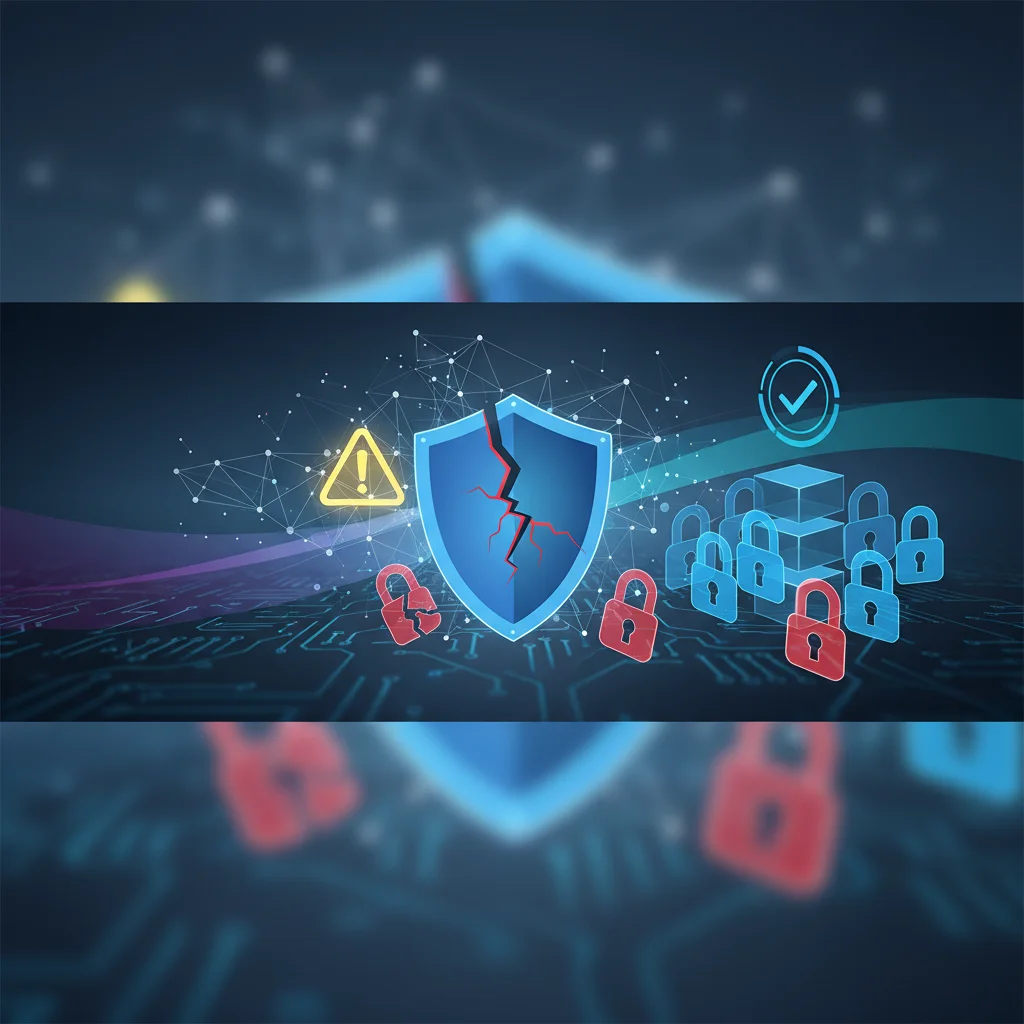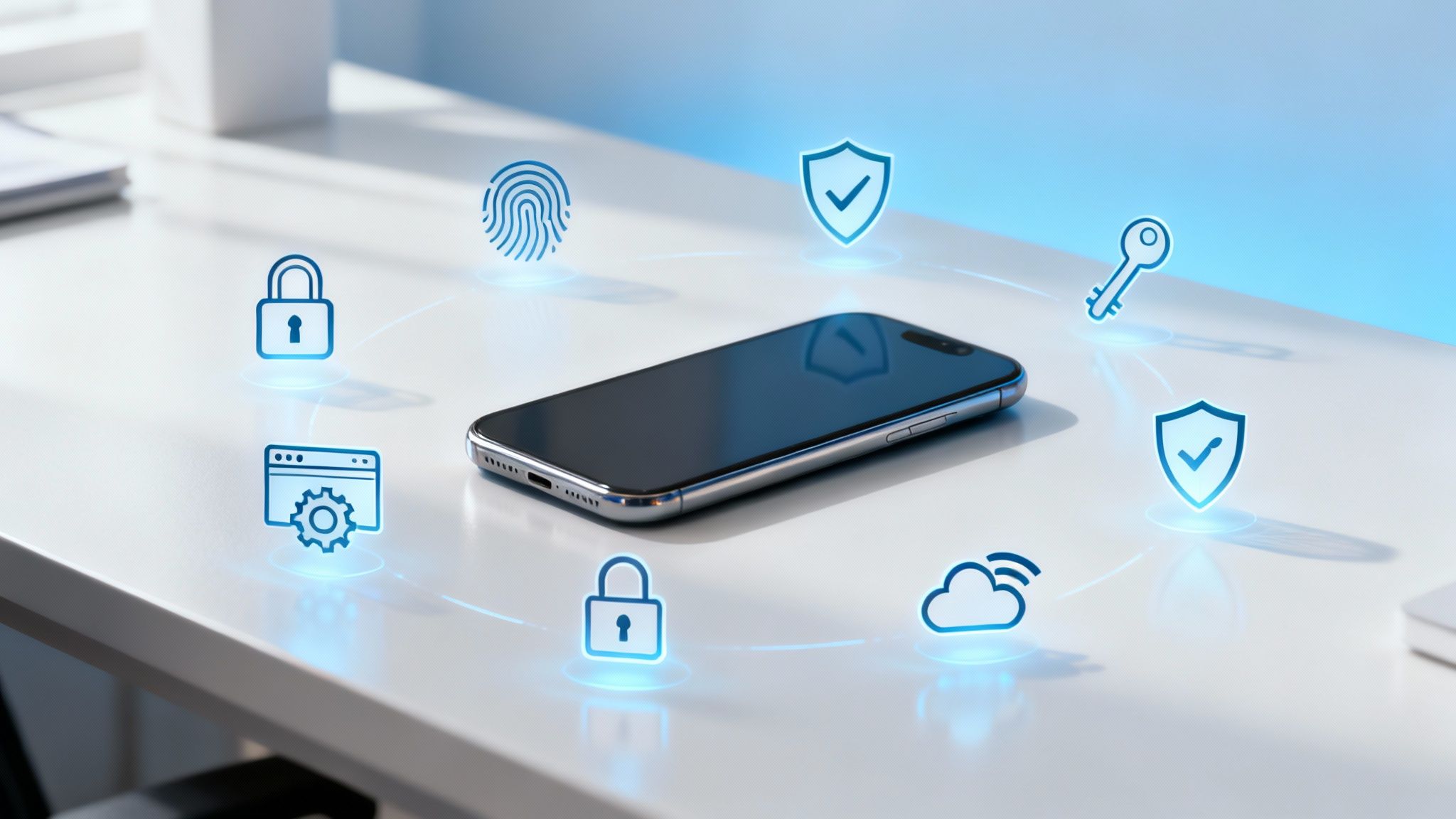· Digital Footprint Check · Content Marketing · 19 min read
cybersecurity tips for small businesses: Quick security wins
cybersecurity tips for small businesses: Learn MFA, data backups, employee training, and smart steps to prevent breaches.

In today’s interconnected economy, small businesses are prime targets for cyber threats, with a staggering 43% of all cyberattacks aimed directly at them. The dangerous misconception of being ‘too small to be a target’ can lead to devastating consequences. A single data breach can trigger crippling financial losses, inflict severe reputational damage, and halt operations indefinitely. Proactive cybersecurity is not an enterprise-level luxury; it is a fundamental requirement for survival and sustainable growth.
This guide moves beyond generic advice to provide 10 actionable, prioritized cybersecurity tips for small businesses that you can implement immediately. We will explore practical steps across policy, technology, and employee training designed to build a resilient defense. These strategies will help you protect sensitive customer and company data, securing your future against sophisticated digital threats. For a deeper dive into establishing a robust defense strategy, consider this comprehensive essential guide to network security for small businesses. This article focuses on tangible actions you can take right now to fortify your digital perimeter and transform security from a reactive measure into your greatest competitive asset. Let’s begin.
1. Implement Strong Password Policies
Your employees’ passwords are the primary keys to your digital kingdom, and weak or reused credentials are a leading cause of security breaches. A strong password policy moves beyond simple suggestions and establishes enforceable, system-wide rules for creating and managing these critical credentials. This policy acts as your first and most fundamental line of defense, significantly reducing the risk of unauthorized access from brute-force attacks and credential stuffing.

For a small business, this is a non-negotiable security measure. You can configure most business platforms, like Microsoft 365 or Google Workspace, to enforce these rules automatically, ensuring no account is left vulnerable.
Actionable Implementation Steps
- Set Clear Requirements: Mandate a minimum password length of 16 characters. Instead of focusing on complex character requirements, encourage employees to use passphrases (e.g., “Correct-Horse-Battery-Staple”) which are longer, easier to remember, and harder to crack.
- Deploy a Password Manager: Provide a business password manager like Bitwarden or 1Password. This not only helps employees generate and store unique, strong passwords for every service but also allows you to securely share credentials among teams without exposing them.
- Enforce with Multi-Factor Authentication (MFA): Rather than forcing frequent password changes, which often leads to weaker passwords, implement MFA across all possible services. This provides a powerful secondary security layer. For a deeper understanding of securing your accounts, explore these personal cybersecurity best practices.
- Educate Continuously: Include password hygiene training during employee onboarding and conduct annual refreshers to reinforce best practices.
2. Enable Multi-Factor Authentication (MFA)
If strong passwords are the lock on your digital front door, Multi-Factor Authentication (MFA) is the deadbolt. It requires users to provide two or more verification methods to gain access, combining something they know (password), something they have (phone or hardware key), and/or something they are (fingerprint). Even if a cybercriminal steals a password, MFA prevents them from accessing the account, effectively neutralizing the most common attack vector.

For a small business, implementing MFA is one of the most impactful cybersecurity tips you can follow, drastically reducing the likelihood of a breach. Major platforms like Microsoft 365 and Google Workspace have made it simple to enforce this critical security layer, moving it from a “nice-to-have” to a fundamental business requirement.
Actionable Implementation Steps
- Prioritize Critical Accounts: Immediately enable MFA for all administrative, financial, and email accounts. These high-value targets are the most attractive to attackers and require your strongest defenses.
- Opt for App-Based Authenticators: Instead of SMS, which can be vulnerable to SIM-swapping attacks, guide your team to use authenticator apps like Google Authenticator or Microsoft Authenticator. These generate secure, time-sensitive codes directly on their device.
- Invest in Hardware Keys for Admins: For accounts with the highest level of privilege, provide hardware security keys like YubiKeys. These physical devices offer the strongest form of authentication, making unauthorized remote access nearly impossible.
- Train and Prepare Your Team: Before rolling out MFA company-wide, train your staff on how it works and establish clear procedures for account recovery. This ensures a smooth transition and minimizes disruption if a user gets locked out.
3. Regular Security Awareness Training
Your employees are your greatest asset, but they can also be your biggest security vulnerability. Attackers frequently target the human element through phishing, social engineering, and pretexting. Regular security awareness training transforms your team from a potential liability into a proactive human firewall, equipping them to recognize and report threats before they cause damage. This ongoing education is one of the most effective cybersecurity tips for small businesses to reduce human error.
For a small business, a single successful phishing attack can be devastating. By investing in training, you build a culture of security where every employee understands their role in protecting sensitive company and customer data, significantly lowering your risk profile.
Actionable Implementation Steps
- Conduct Phishing Simulations: Use a platform like KnowBe4 to send safe, simulated phishing emails to your team monthly. This provides practical, real-world experience in identifying malicious messages and helps measure your team’s susceptibility over time.
- Keep Training Bite-Sized and Relevant: Instead of long annual sessions, deliver short, 10-15 minute training modules quarterly. Focus on current threats and use real-world examples from your industry to make the content engaging and memorable.
- Create a Safe Reporting Culture: Emphasize that reporting a suspected phishing attempt, even if an employee clicked a link, will never result in punishment. A positive reporting culture encourages employees to come forward quickly, allowing your IT team to mitigate threats faster. Phishers use OSINT techniques to craft convincing emails; understanding how OSINT tools work can help your team appreciate the sophistication of these attacks.
- Measure and Gamify: Track key metrics like phishing click rates, reporting rates, and training completion. Introduce friendly competition or rewards for employees who consistently spot and report simulated phishes to boost engagement and participation.
4. Keep Software and Systems Updated
Outdated software is a wide-open door for cybercriminals. Every application, operating system, and firmware on your network can contain vulnerabilities that, once discovered, become targets. Software updates, often called patches, are released by vendors specifically to close these security gaps. Failing to apply them leaves your business exposed to known exploits that attackers can easily automate and launch at scale.
For a small business, a disciplined patch management process is one of the most effective cybersecurity tips for preventing attacks like ransomware. The infamous 2017 WannaCry attack, for instance, devastated organizations running unpatched Windows systems, while those who had applied the available update were completely immune. This highlights how a simple, proactive step can prevent a catastrophic breach.
Actionable Implementation Steps
- Enable Automatic Updates: For operating systems (Windows, macOS) and major software suites (Microsoft 365, Adobe Creative Cloud), turn on automatic updates. This ensures critical security patches are applied as soon as they become available with minimal manual effort.
- Establish a Patching Schedule: Create a formal policy for regularly updating all software. Designate a specific time, such as a monthly maintenance window, to apply updates to servers and critical applications that require manual intervention.
- Prioritize Critical Vulnerabilities: Monitor security bulletins from vendors like Microsoft and CISA. When a “critical” or “zero-day” vulnerability is announced, prioritize deploying that patch immediately across all affected systems instead of waiting for your next scheduled window.
- Maintain an Asset Inventory: You can’t protect what you don’t know you have. Keep a simple, updated list of all software and hardware on your network. This makes it easier to track which systems need patching and ensures nothing is overlooked.
5. Use Data Encryption
Encryption is the process of encoding sensitive data, transforming it from a readable format into an unreadable one that can only be accessed with a proper decryption key. It serves as a critical safeguard for your business information, protecting it both when it’s stored on your systems (at rest) and when it’s being sent over the internet (in transit). Even if a cybercriminal manages to steal your data, strong encryption renders it completely useless without the corresponding key.
For any small business handling customer information, financial records, or intellectual property, encryption is not optional; it’s a foundational security control. Most modern operating systems and cloud services offer built-in encryption tools, making this powerful protection accessible without significant investment.
Actionable Implementation Steps
- Enable Full Disk Encryption: Immediately activate the native encryption tools on all company devices. Use BitLocker for Windows and FileVault for macOS to protect all data stored on laptops and desktops, ensuring that stolen hardware does not lead to a data breach.
- Secure Data in Transit: Ensure your company website and any client portals use HTTPS, which is enabled by an SSL/TLS certificate. This encrypts all communication between your user’s browser and your server, protecting login credentials and other submitted data.
- Encrypt Portable Media: Mandate that all external hard drives and USB sticks used for business purposes are encrypted. This prevents sensitive files from being compromised if a device is lost or misplaced during travel or off-site work.
- Protect Your Database: Encrypt databases containing sensitive information, such as customer lists or payment details. To effectively protect your business’s sensitive information from unauthorized access, it is critical to understand encryption technologies and apply them correctly.
6. Implement Regular Data Backups
A data disaster, whether from a ransomware attack, hardware failure, or accidental deletion, can stop a small business in its tracks. Regular data backups create copies of your critical information, storing them separately from your live systems. This practice is your ultimate safety net, ensuring you can restore operations quickly and avoid catastrophic data loss without paying a ransom.

For a small business, this isn’t just a technical task; it’s a core component of business continuity. Losing client data, financial records, or intellectual property can be an extinction-level event. By implementing a robust backup strategy, you ensure your business can survive such an incident and recover.
Actionable Implementation Steps
- Follow the 3-2-1 Rule: Maintain at least three copies of your data on two different media types (e.g., local hard drive and cloud storage), with one copy stored off-site. This layered approach minimizes the risk of a single event wiping out all your data.
- Automate Everything: Manual backups are prone to human error and are easily forgotten. Use solutions like Backblaze, Acronis, or the built-in features of your cloud provider to automate daily backups, ensuring consistency and reliability without manual intervention.
- Test Your Restores: A backup is useless if it can’t be restored. Schedule monthly or quarterly tests to restore a sample of files or a full system to a test environment. This verifies the integrity of your backups and confirms your recovery procedures work as expected.
- Isolate and Secure Backups: Ensure your backups are “air-gapped” or stored on a network segment isolated from your main production environment. Implement immutable storage, where data cannot be altered or deleted for a set period, to protect backups from being encrypted during a ransomware attack.
7. Secure Remote Access and VPN Usage
As remote and hybrid work models become standard, securing the connections your employees use to access company resources from outside the office is critical. A Virtual Private Network (VPN) creates an encrypted tunnel over the internet, protecting data from eavesdropping. However, modern security moves beyond just VPNs to a zero-trust model, which verifies every access request regardless of its origin. This combined approach is a crucial cybersecurity tip for small businesses, preventing attackers from using remote connections as an entry point.
For a small business, this means moving beyond consumer-grade VPNs and implementing business-focused solutions that offer centralized management, monitoring, and stronger security controls. Services like Cloudflare Zero Trust or purpose-built VPNs like OpenVPN provide the necessary tools to lock down your network perimeter effectively.
Actionable Implementation Steps
- Choose Business-Grade Solutions: Deploy a dedicated business VPN or a Zero Trust Network Access (ZTNA) solution. Avoid consumer VPNs, as they lack the management and logging features necessary for corporate security.
- Enforce MFA for All Remote Access: Require multi-factor authentication for every VPN or remote access login. This ensures that even if an employee’s credentials are stolen, an attacker cannot gain access without the second verification factor.
- Disable Split Tunneling: Configure your VPN to route all of the employee’s internet traffic through the corporate network. This prevents them from accessing potentially malicious sites on an unsecured connection while connected to your resources.
- Monitor and Log Access: Actively monitor and log all remote connection attempts. Review these logs regularly for unusual activity, such as logins from unexpected locations or at odd hours, which could indicate a compromised account.
8. Establish Firewall and Network Segmentation
Your network is the central nervous system of your business, and without proper defenses, a single breach can spread rapidly. A firewall acts as a digital gatekeeper, monitoring and controlling incoming and outgoing network traffic based on predetermined security rules. Paired with network segmentation, which divides your network into smaller, isolated sub-networks, this strategy drastically limits an attacker’s ability to move laterally and access critical assets if they breach one area.
For a small business, this is a crucial step beyond the basic router provided by your internet service provider. Implementing a dedicated firewall and segmenting your network contains threats, protecting sensitive data in one zone (like finance) from a potential compromise in another (like a public guest Wi-Fi). This layered defense is a core principle of modern cybersecurity tips for small businesses.
Actionable Implementation Steps
- Deploy a Dedicated Firewall: Use a business-grade firewall from providers like Ubiquiti, Fortinet, or an open-source solution like pfSense. These offer more granular control and advanced features than standard consumer routers.
- Create Logical Segments: Divide your network into zones based on function and trust level. For example, create separate networks for your internal operations, point-of-sale systems, guest Wi-Fi, and any Internet of Things (IoT) devices.
- Apply the Principle of Least Privilege: Configure firewall rules to only allow the absolute minimum traffic necessary for each segment to function. If the guest network doesn’t need to communicate with the finance department’s servers, block that traffic entirely.
- Regularly Review and Audit Rules: Schedule quarterly reviews of your firewall rules to remove any that are obsolete or overly permissive. An outdated rule can become an unintentional backdoor for attackers.
9. Monitor, Log, and Maintain an Incident Response Plan
You cannot respond to threats you cannot see. Actively monitoring your digital environment through logging and analysis is critical for detecting suspicious activity, but detection alone is insufficient. Combining this monitoring with a documented Incident Response Plan (IRP) ensures you can react swiftly and effectively when an incident does occur, minimizing damage, downtime, and reputational harm. This proactive stance transforms security from a passive defense to an active, coordinated strategy.
For a small business, a documented plan prevents panic and chaos during a crisis. It provides a clear, step-by-step guide for your team to follow, ensuring a consistent and legally compliant response. Having this framework in place before a breach is one of the most vital cybersecurity tips for small businesses looking to build resilience.
Actionable Implementation Steps
- Establish Centralized Logging: Start by collecting essential logs from critical systems like firewalls, servers, and key applications into a single location. Services like Splunk Cloud or Microsoft Sentinel can simplify this process, making it easier to search for and analyze security events.
- Define and Practice Your IRP: Document clear procedures for identifying, containing, eradicating, and recovering from different types of security incidents. Your plan should include key contacts (internal team, legal counsel, cyber insurance) and communication templates. Conduct quarterly tabletop exercises to test and refine the plan.
- Set Up Critical Alerts: Configure your monitoring system to send immediate alerts for high-risk activities, such as multiple failed login attempts from a single IP address, unexpected privilege escalations, or data transfers to unknown destinations. This enables rapid intervention before a minor issue becomes a major breach.
- Know Your Tools: Effective monitoring relies on the right technology. Explore some of the top tools for monitoring your digital footprint to understand what solutions can provide visibility into your systems.
10. Conduct Regular Security Assessments and Penetration Testing
You cannot protect what you don’t know is vulnerable. Regularly evaluating your security posture through vulnerability assessments and penetration tests moves you from a reactive to a proactive defense. These controlled, authorized tests simulate an attack on your systems, identifying weaknesses before malicious actors can exploit them and helping you prioritize critical fixes.
This process is like a regular health checkup for your digital infrastructure. For a small business, conducting these assessments provides invaluable, objective insight into your actual security readiness, rather than relying on assumptions. It helps you focus limited resources on the most significant risks, ensuring your cybersecurity tips for small businesses are having a real impact.
Actionable Implementation Steps
- Schedule Annual Assessments: Commit to a third-party penetration test at least once a year. For more critical systems, such as those handling customer payments, consider quarterly automated vulnerability scans to maintain a constant watch.
- Scope the Test Carefully: Define what the assessment should cover. Focus on your highest-risk assets first, such as your primary website, customer database servers, and any internet-facing applications. This ensures you get the most value from your investment.
- Combine Automated and Manual Testing: Use automated scanners like Nessus or Qualys for broad coverage to find common vulnerabilities. Complement this with manual testing by security professionals, who can uncover complex business logic flaws that automated tools often miss.
- Prioritize and Remediate Findings: Your assessment will produce a report detailing vulnerabilities, often ranked by severity (e.g., Critical, High, Medium, Low). Create a remediation plan that addresses the most critical and easily exploitable issues first, and then retest to confirm the fixes are effective.
10-Point Small Business Cybersecurity Comparison
| Control | Implementation Complexity 🔄 | Resource Requirements ⚡ | Expected Outcomes ⭐ | Ideal Use Cases 💡 | Key Advantages 📊 |
|---|---|---|---|---|---|
| Implement Strong Password Policies | Moderate — policy + enforcement across systems | Low — admin time, directory/policy tools | Moderate ⭐ — reduces brute-force, limited vs phishing | Baseline auth control for all orgs, SMBs | Inexpensive, improves compliance, broad coverage |
| Enable Multi-Factor Authentication (MFA) | Low–Moderate — integrate providers and devices | Low–Moderate — auth apps, tokens, support staff | Very High ⭐ — drastically reduces account takeover | Protect admin, email, financial and cloud accounts | Strong phishing protection, regulatory support |
| Regular Security Awareness Training | Low — program set-up and ongoing delivery | Low–Moderate — training platform, staff time | High ⭐ — lowers phishing click rates and human risk | Organizations with distributed workforce | Builds security culture, measurable behavior change |
| Keep Software and Systems Updated | Moderate–High — patch testing, scheduling, rollout | Moderate–High — patch tools, test environments, IT staff | High ⭐ — eliminates many known exploit vectors | All organizations, especially critical systems | Reduces vulnerabilities, improves stability/compliance |
| Use Data Encryption | Moderate — implement encryption and key management | Moderate — KMS/HSM, encryption tools, expertise | High ⭐ — protects data at rest and in transit | Regulated data, customer PII, backups, mobile devices | Minimizes breach impact, supports GDPR/HIPAA/PCI |
| Implement Regular Data Backups | Moderate — design, automation, verification | Moderate–High — storage, backup software, testing | High ⭐ — enables recovery from ransomware/hardware failure | Any org requiring business continuity and RTOs | Ensures recoverability, supports disaster recovery |
| Secure Remote Access and VPN Usage | Moderate — VPN/zero-trust policies and device checks | Moderate — VPN/zero-trust solutions, MFA, endpoints | High ⭐ — secures remote connections, reduces exposure | Hybrid/remote workforces, contractors | Protects public-network traffic, supports BYOD securely |
| Establish Firewall and Network Segmentation | High — network design, rule management, maintenance | Moderate–High — NGFWs, VLANs, skilled admins | High ⭐ — limits lateral movement, reduces attack surface | Environments needing isolation (OT, PCI, healthcare) | Granular traffic control, improved monitoring and containment |
| Monitor, Log, and Maintain an Incident Response Plan | High — SIEM/EDR deployment, playbooks, drills | High — tooling, storage, analysts or MSSP | Very High ⭐ — rapid detection, coordinated response | Organizations with sensitive data or compliance needs | Improves MTTD/MTTR, provides forensic evidence, compliance |
| Conduct Regular Security Assessments & Pen Testing | Moderate–High — scoping, testing windows, remediation | Moderate–High — external testers, tools, remediation effort | High ⭐ — identifies vulnerabilities before exploitation | Compliance-driven orgs, high-risk apps and infra | Prioritizes fixes, validates controls, demonstrates diligence |
Building a Culture of Security: Your Path Forward
Navigating the digital landscape can feel daunting, but implementing robust cybersecurity is not an insurmountable task. The ten cybersecurity tips for small businesses detailed in this guide are not just a checklist to be completed once. They are the foundational pillars of an ongoing, proactive security strategy designed to protect your most valuable assets, from sensitive customer data to your hard-earned reputation. Think of it less as a project with a finish line and more as a core business function, as essential as sales, marketing, or customer service.
The journey begins with high-impact, low-complexity steps. Enforcing strong password policies and universally enabling Multi-Factor Authentication (MFA) are your first lines of defense, creating immediate barriers against unauthorized access. Simultaneously, investing in regular security awareness training transforms your greatest potential vulnerability, your employees, into your most vigilant security asset. These foundational actions create a powerful initial shield.
From Defense to Resilience
Once these basics are in place, the focus shifts from simple defense to building genuine operational resilience. This is where layering more advanced controls becomes critical. Regular software updates patch known vulnerabilities, while data encryption ensures that even if data is compromised, it remains unreadable and unusable to attackers. Complementing this with a robust data backup and recovery plan means you can restore operations swiftly after an incident, minimizing downtime and financial loss.
Securing your network with firewalls, segmenting internal systems to contain potential breaches, and establishing secure remote access protocols are the next logical steps. These measures create a hardened perimeter and a controlled internal environment. The final, and perhaps most crucial, layer involves continuous vigilance. Implementing a formal incident response plan, actively monitoring your systems for threats, and conducting periodic security assessments ensures your defenses evolve and adapt to the ever-changing threat landscape.
A Continuous Commitment to Protection
Ultimately, these cybersecurity tips for small businesses are about fostering a company-wide culture of security. It’s a commitment that starts from the top down and permeates every department. Each policy implemented, every training session conducted, and every system updated contributes to a stronger, more resilient organization. This proactive stance not only safeguards your business from financial and reputational damage but also builds invaluable trust with your customers, who are increasingly aware of the importance of data privacy. By integrating these practices into your daily operations, you are not just preventing threats; you are building a secure foundation for sustainable growth and long-term success in an interconnected world.
Ready to take the first step in understanding your company’s online exposure? Digital Footprint Check scans the web for data breaches, leaked credentials, and mentions of your business, giving you the visibility needed to apply these cybersecurity tips effectively. Discover what’s out there and protect your digital identity by visiting Digital Footprint Check today.



